Zeal 8-bit Video Board (homebrew VGA board powered by FPGA)
Designed by Zeal8bit in China
Buy with confidence.
Our Tindie Guarantee protects your purchase from fraud. Learn More
Update 3D printed case for Zeal 8-bit Video board is available! Choose your favorite color: Classic White PLA Matte Grey PLA Silk Silver with a special Diamond Cut Surface finish Enjoy modern ret…
Read More… 3D printed case for Zeal 8-bit Video board is available! Choose your favorite color:
3D printed case for Zeal 8-bit Video board is available! Choose your favorite color:
The project Zeal 8-bit Video Board is part of another bigger project: the Zeal 8-bit Computer. Started in early 2021, the goal is to make a homebrew 8-bit computer that keeps the same simplicity of retro microcomputers, like the Commodore 64 or the ZX Spectrum, while providing more recent features like VGA graphics, TF card support or NOR flash storage.
If you want to learn more on Zeal 8-bit computer project, you can check the dedicated Tindie page, my official website zeal8bit.com or my Youtube channel Zeal8bit.
This edition of the Zeal 8-bit Video Board is made for developers, who are eager to port or develop games or graphical programs to it. Indeed, its rich features makes it possible to port almost any retro 8-bit game! Feel free to take part into the development, the community is getting bigger and bigger!

This product includes a pre-assembled, pre-flashed and pre-tested Zeal 8-bit Video Board. Its main components are the following: Lattice ECP5 FPGA VGA output, which can output up to 65536 colors 3.5mm jack audio output Volume wheel TF card port Standard 2.54mm 2x20-pin Bus connector to connect Zeal 8-bit Computer or any other 8-bit computer. The address, control and data lines are bi-directional (to let the FPGA perform DMA operations) Standard 2.54mm 1x2-pin DMA connector (unused for now) 1.1V, 2.5V and 3.3V regulators, the board only require a single 5V power supply (provided via the bus connector) 5V-to-3.3V level shifters, which make the bus connector 5V-tolerant One power LED Two general-purpose LEDs USB Type-C power input. Only used for development purpose, it should only be used if the bus connector is not connected since the latter must provide the 5V power input.
So, you will get:
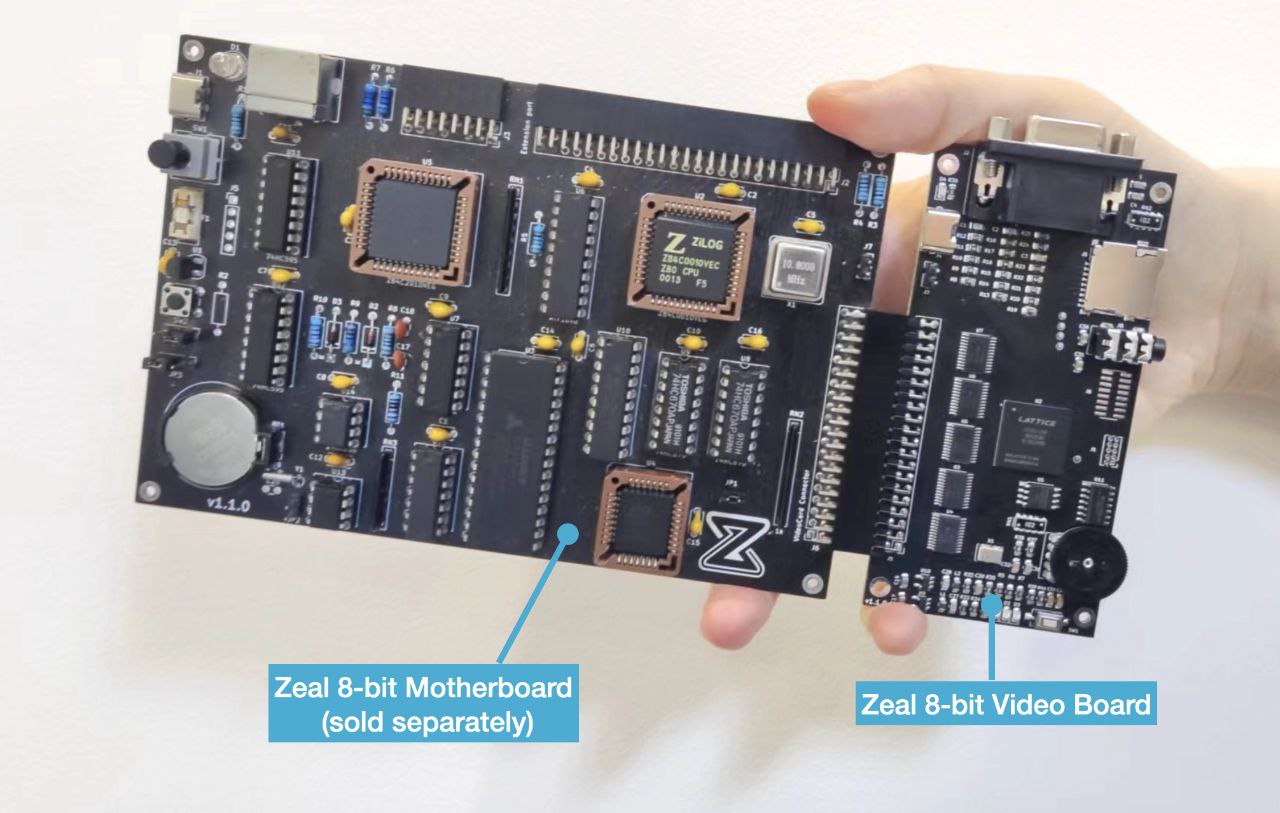
Here are the features of the board:
| Features | Details | Description |
|---|---|---|
| Video | Resolutions | 640x480, 320x240 |
| Color depth | 16-bit, RGB565 | |
| Video RAM | ~80KB of internal memory, no need for external RAM! | |
| Memory | 128KB of mapped memory (check memory mapping below) | |
| Text mode | 80x40 characters, wrapped when scrolled 40x20 characters, showing hidden characters when scrolled | |
| 16 colors per character, for both foreground and background, taken from a palette | ||
| 8x12px per character | ||
| Font Table of 256 characters, 12 bytes per characters, customizable at runtime | ||
| Hardware cursor, scroll, wait-on-newline support | ||
| Graphics mode | Virtual resolution of 1280x640, only 640x480 or 320x240 can be visible at once | |
| Hardware scrolling to show hidden parts | ||
| Color palette (RGB565 colors) usable as a single 256-color palette or 16 16-color palettesPalette customizable at runtime | ||
| 16x16px tiles, 8bpp or 4bpp | ||
| 640x480px resolution, 40x30 tiles visible on screen320x240px resolution, 20x15 tiles visible on screen | ||
| Up to 256 different tiles on screen at the same time in 8bpp mode (256-color palette)Up to 512 different tiles on screen at the same time in 4bpp mode (16 16-color palette) | ||
| One background layer, one foreground layer with transparency in 8bpp modeSingle layer in 4bpp mode | ||
| Sprites | 128 hardware sprites, up to 40 sprites per scanline | |
| 16x16px tiles, taken from the same tileset than the other layers | ||
| Flip X and flip Y supported | ||
| Can be hidden behind foreground layer in 8bpp mode | ||
| Can be partially hidden in the screen borders | ||
| Audio | PSG | 4 voices |
| Each voice can generate triangle waves, sawtooth waves, squares waves or noise | ||
| Sample table | 256-byte sample table to generate arbitrary sound | |
| Configurable sample rate | ||
| SPI | TF Card | Interface up to 25MHz, configurable |
| Hardware FIFO | ||
| Miscellaneous | Recovery mode, to be able to upgrade the firmware from the 8-bit computer | |
| Modular memory mapping thanks to configuration registers | ||
| Hardware v-blank interrupt line | ||
| Hardware general purpose interrupt line (unused for now) |
The bus connector is as follows (front view of it):
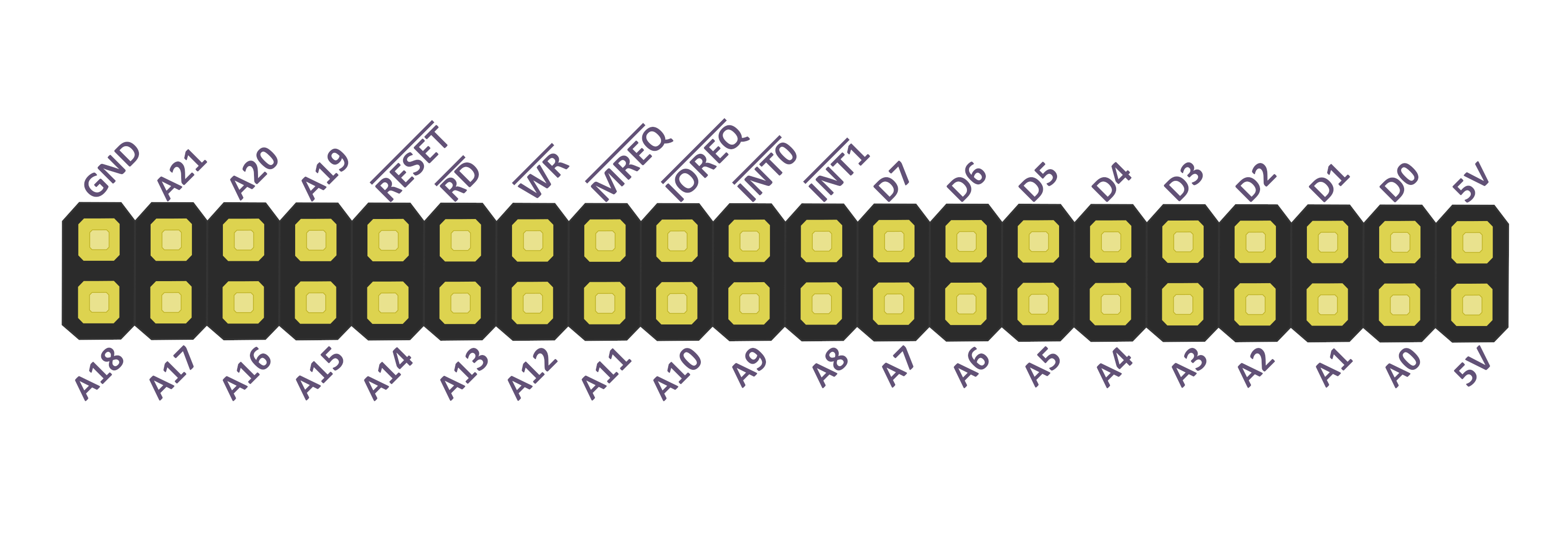
All signals marked with a bar on top are active-low.
| Pin | Direction | Description |
|---|---|---|
| A21-A17 | Bidirectional | Upper bits of the physical address of the 8-bit computer. On boot and reset, the FPGA maps its VRAM at 0x100000 (1MB). In other words, it will select itself if A21, A19, A18 and A17 are LOW and A20 is HIGH. As such, on computers that don't have such a big physical address space can consider these pins as chip selects. |
| A16-A0 | Bidirectional | Lower bits of the physical address of the 8-bit computer. Since the FPGA uses 128KB of memory, 17 bits are required. Check the memory mapping below for more information. |
| D7-D0 | Bidirectional | Data bus, input when the board is selected and WR is asserted (low), output when the board is selected and RD is asserted (low) |
| RESET | Bidirectional | Reset signal, active-low. This signal must be in an open-drain configuraiton. Even though this signal is bidirectional, the video board currently never asserts it itself. |
| RD | Bidirectional | Read signal, active-low. This signal is used to notify the board that a READ is requested by the motherboard. This is used in both IOREQ and MREQ. Even though this signal is bidirectional in hardware, the video board currently only uses it as input. |
| WR | Bidirectional | Write signal, active-low. This signal is used to notify the board that a WRITE is requested by the motherboard. This is used in both IOREQ and MREQ. Even though this signal is bidirectional in hardware, the video board currently only uses it as input. |
| MREQ | Bidirectional | Memory request signal, active-low. This signal is used to notify the board that a MEMORY REQUEST is requested by the motherboard. This follows the Z80 bus segmentation with a memory bus that makes us the use of all the address lines, and an I/O bus that only makes the use of the lowest 8 address lines (8-bit). Even though this signal is bidirectional in hardware, the video board currently only uses it as input. |
| IOREQ | Bidirectional | I/O request signal, active-low. This signal is used to notify the board that an I/O REQUEST is requested by the motherboard. During this request, only the lower 8-bit of address will be taken into account. For 8-bit computers that don't have such bus and only have a memory bus, this signal can be hardwired to HIGH. All the I/O modules can also be accessed via the memory bus. Check the memory mapping below for more information. Even though this signal is bidirectional in hardware, the video board currently only uses it as input. |
| INT1 | Output (3.3V) | General purpose interrupt signal, active-low. This output signal notifies the motherboard when a peripheral has a pending interrupt. It is currently not used but it is planned to have SPI, sound, timer and graphics interrupts. This line must NEVER be wired to a voltage higher than 3.3V to prevent damaging the FPGA! |
| INT0 | Output (3.3V) | V-blank interrupt signal, active-low. This output signal notifies the motherboard that the display component just entered v-blank state. This line must NEVER be wired to a voltage higher than 3.3V to prevent damaging the FPGA! |
As stated above, The video board follows the Z80 bus segmentation, which means that there are two different buses: the memory bus, using all the address lines, and the I/O bus, only using the lowest 8-bit lines of address. However, keep in mind that the components accessible via the I/O bus can also be accessed via the memory bus, making it possible for 8-bit computers with only a single bus to use all components.
IMPORTANT: the effective VRAM we are talking about here is internal to the video board, it is not required for the 8-bit computer/motherboard to provide any RAM
Let's start with the mapping on the memory bus:

The video board memory start PADDR physical address. On boot and reset, PADDR is internally set to 0x100000 (1MB). In other words, the board will enable itself if A21, A19, A18 and A17 are LOW and A20 is HIGH. This can be configured with a register write, so please note that PADDR is always aligned on 128KB.
The first part of the memory, which is mapped to the first 16KB, is organized as follows:
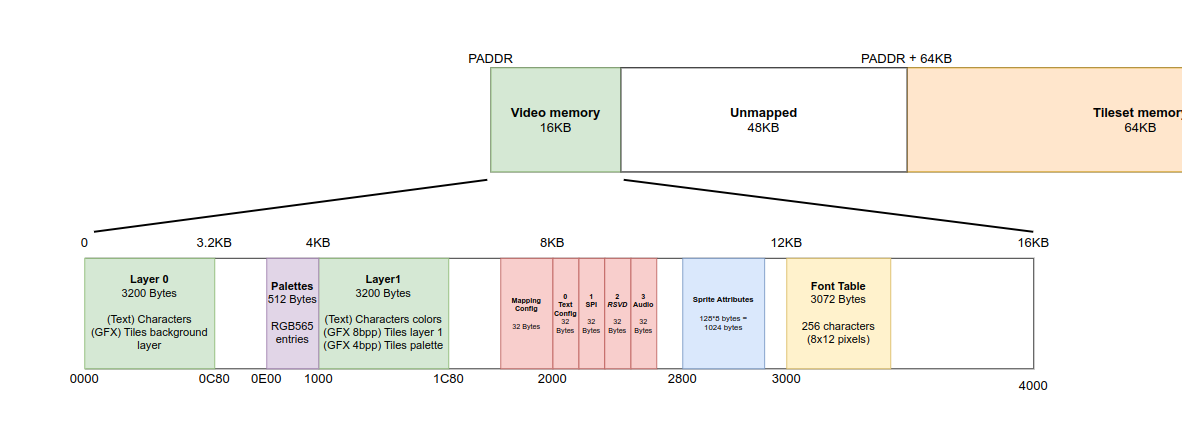
Note: the blanks between components is unmapped memory, the video board will not reply to any request performed there but it must not be used by any other hardware.
The first 3200 bytes are allocated to the Layer0, which is a write-only memory representing:
The next component, mapped at 0xE00 is the write-olnly color palette, where each entry is a little-endian 16-bit word representing an RGB565 color. Bytes can be written independently from each other in this table. This palette can be interpreted as 16 palettes of 16 colors in graphics 4bpp mode. In text mode, only the first 16 entries will be taken into account. On boot (not reset), this table will be pre-loaded with the VGA/Mode 13h 8-bit color palette.
Right after the palette is the Layer1, which is also write-only and represents:
0xF2 represents a character with color 15 as its background and color 2 as the character color. In 40x20 characters mode, this is still valid, it is possible to set the colors of hidden characters, before they are even shown on screen.0x21, the index of the tile to show will be (1 << 8) | layer[10] and it shall be drawn with the palette of index 2. This lets us have different 512 tiles in this mode, and even draw the same tile several times on screen but with different colors.After the Layer1 comes the Mapping config which controls where the video board is be mapped on the physical address space. It also controls which peripheral is mapped to the I/O bank. See below for more information about this peripheral.
Each peripheral or future extension will be mapped right after, between 0x2000 and 0x2800. Each of them will be given 32 registers/bytes. We can have up to 64 peripherals in that space.
For more information about each of these peripheral, check the description below.
The sprite attributes memory starts at offset 0x2800, it is representing an array of 128 attributes, each of them being 8 bytes:
![]()
16. Simiarly, wirting 8 to this register would result in a sprite that is half hidden/half shown at the top of the screen. Thus, a value of 0 would completely hide the sprite.A few remarks on the sprites:
The sprite attributes memory is write-only.
They only visible in graphics mode, they won't be shown in text mode
They are not affected by screen scrolling
They are always 16x16px big
They share the same tileset as the layer0 and layer1
Despite being organised as a 16-bit word memory, it is possible for the CPU to only write a single byte without affecting the other one
The final area of the video memory region is the font table, on characters memory. There are a total of 256 characters, each character is 8x12 pixels bisg and thus utilizes 12 bytes. Characters are encoded as bitmaps, where one line is encoded by one byte: bit 1 is a foreground pixel, 0 is a background pixel. This part of memory is r/w, so it can be read by the CPU (mainly to backup the font).
For example, the character 0 can encoded as 0x00, 0x3c, 0x42, 0x42, 0x42, 0x42, 0x42, 0x42, 0x42,0x3c, 0x00, 0x00:
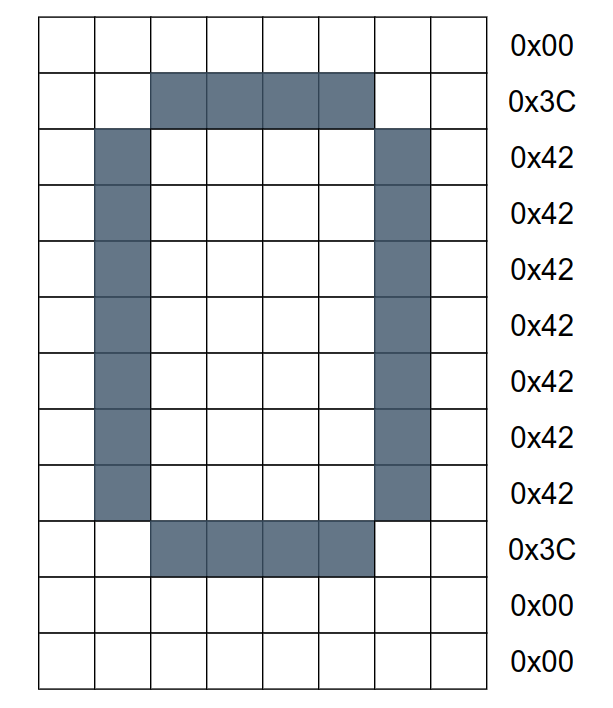 These bytes must be stored starting at offset
These bytes must be stored starting at offset 0x30 of the table to respect ASCII encoding.
On boot (not reset), the font preset in the font table is the BigBlue character set, created by VileR, licensed under the Attribution-ShareAlike 4.0 International. No changes have been made to this font.
The upper half (64KB) of memory mapped for the video board is the write-only tileset memory. In text mode, this memory is not used at all, writing to it is still possible or course.
In 8bpp graphics mode, each tile is 256 bytes big, and each byte represent a color index to get from the color palette. This gives us a tileset memory of 256 x 256 = 64KB.
In 4bpp graphics mode, each tile is 128 bytes big, each byte represents two adjacent pixels. In fact, each nibble represent a color index to search in a 16-color/4-bit palette. The palette is either specified in the Layer1 or in the sprite attributes. This means that a single tile can be shown with different colors on screen. Since the tileset memory is write-only, you must be aware that each byte write will affect two pixels in this mode!
The tileset memory is organised on a per-tile basis, so the first 256 bytes (128 in 4bpp) represent the first tile, tile 0. In 4bpp mode, the higher nibble represents the first pixel, the lower nibble represents the second pixel.
This memory can be written at anytime, even if the video controller is not in a H-blank or V-blank.
To simplify and speed up access to the most common peripherals, the video board also maps itself on the I/O bus:

We can note that the first two modules are the same as the ones available on the memory map described earlier, the difference being that only the first 16 registers are visible on this bus (currently, no peripheral/module has reached this limit yet)
The third 16-byte module is the peripheral bank, it lets the CPU maps any of the 64 peripheral that are mapped at 0x2000 on the main video memory. Again, only the first 16 byte/registers will be shown. This design choice was made to prevent the video board from taking too much space on the I/O bus, which is already very small compared to the main memory.
This bank can take the show the following peripherals:
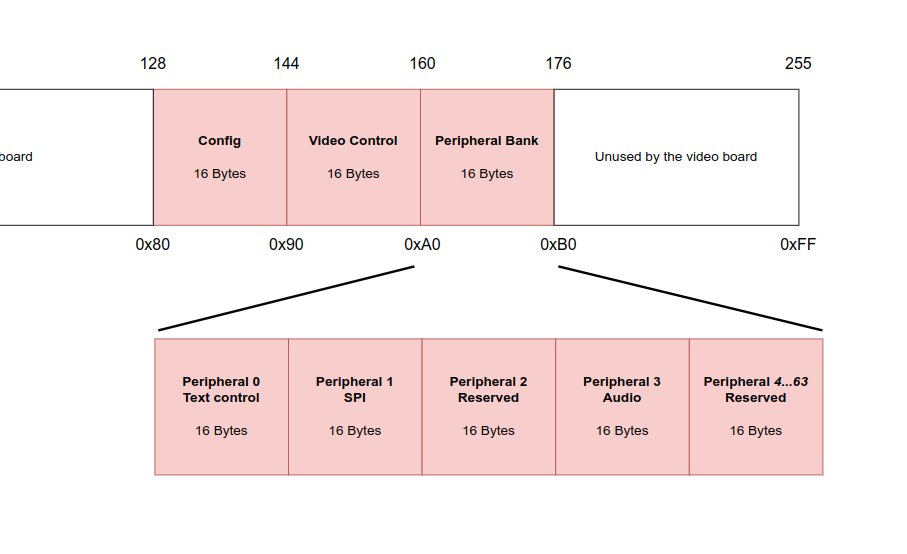
The peripherals won't be explained in details, with each of these registers here, but keep in mind that they will be documented in a dedciated document, and will also be present in header files that are used by Zeal 8-bit OS. You can already find a few details here: video_h.asm
A brief description for each of them:
0x100000 by default) and the peripheral to map to the peripheral bank. It also contains registers with the current firmware version and a few general-purpose scratch registersIf you already have a Zeal 8-bit Computer, you will need to connect the video board on the motherboard's video connector. If this port is not populated, you will need to solder a standard 2.54mm 2x20pin connector (90 degrees). This part will be sent for free if you select it in the accessories list when ordering your Zeal 8-bit Video board.
Afterwards, you will need to update your flashed Zeal 8-bit OS to install the video-enabled version that can be compiled from source: https://github.com/Zeal8bit/Zeal-8-bit-OS
If you need assistance doing this, feel free to contact me or join our Discord server.
It is also possible to update the flashed Zeal 8-bit Bootloader which now has full support for the video board. You will find instructions on the official website of Zeal 8-bit project
Latest version of Zeal 8-bit Bootloader lets you update the video board firmware directly from the Z80. To do so, the video board embeds a secondary special recovery mode firmware that is loaded when the recovery button (bottom right of the board) is pressed. In this mode, there is no video output and both user LEDs will be blinking.
Instructions can be found on the official Github repository of Zeal 8-bit Bootloader project
Zeal 8-bit Video Board official Github project will contain examples to show how to program it.
In the meanwhile, some of my Youtube videos show the capabilities of the video board:
No country selected, please select your country to see shipping options.
No rates are available for shipping to .
Enter your email address if you'd like to be notified when Zeal 8-bit Video Board (homebrew VGA board) can be shipped to you:
Thanks! We'll let you know when the seller adds shipping rates for your country.
| Shipping Rate | Tracked | Ships From | First Item | Additional Items |
|---|---|---|---|---|
|
:
|
Shipping company is subject to change according to the local situation, availability of the shipping company and public holidays.
Product: (5.00)
Documentation: (5.00)
Shipping: (5.00)
Communication: (5.00)
David | July 10, 2024
Carlos | July 3, 2024
Buy with confidence.
Our Tindie Guarantee protects your purchase from fraud. Learn More
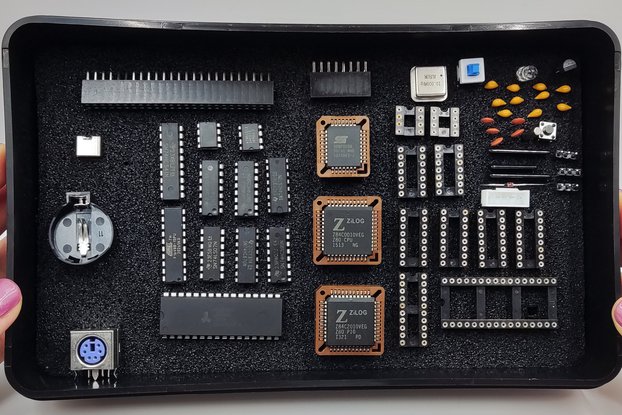
$89.00
Free Shipping!

$9.90
Free Shipping!

$9.90
Free Shipping!
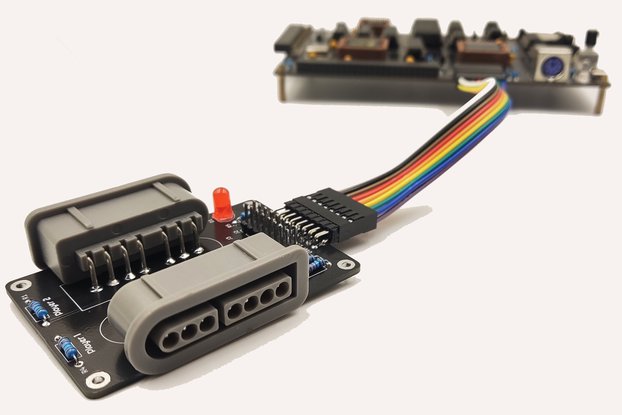
$10.98
Free Shipping!
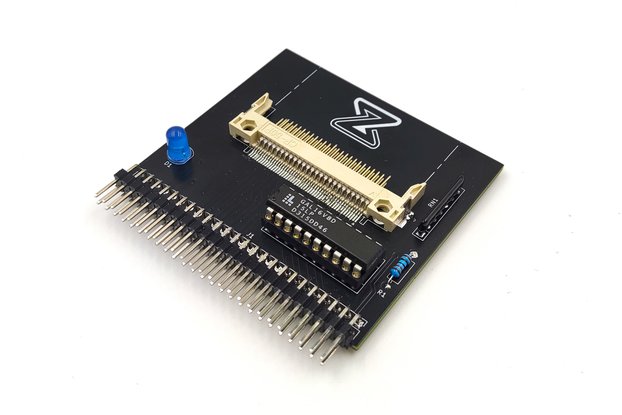
$10.98
Free Shipping!
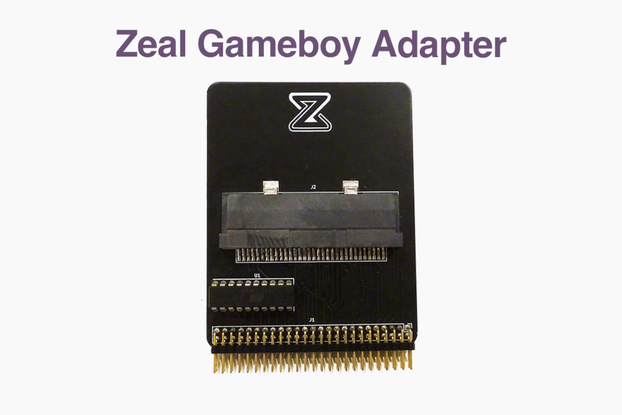
$8.00
Free Shipping!

$99.00
Free Shipping!
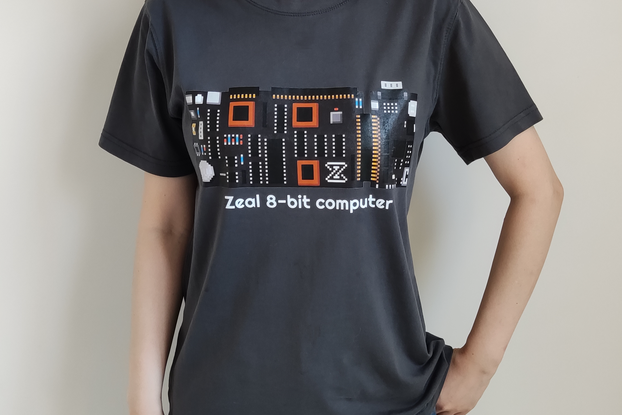
$23.50
Free Shipping!
By clicking Register, you confirm that you accept our Terms & Conditions
We recognize our top users by making them a Tindarian. Tindarians have access to secret & unreleased features.
We look for the most active & best members of the Tindie community, and invite them to join. There isn't a selection process or form to fill out. The only way to become a Tindarian is by being a nice & active member of the Tindie community!
